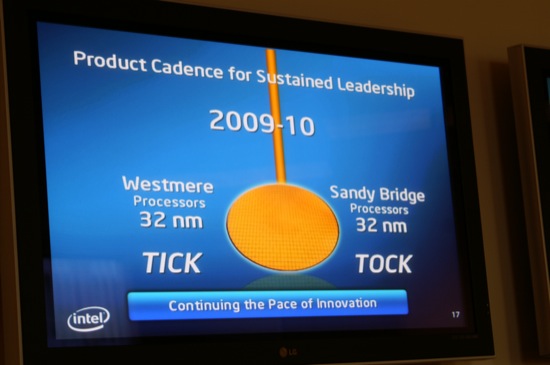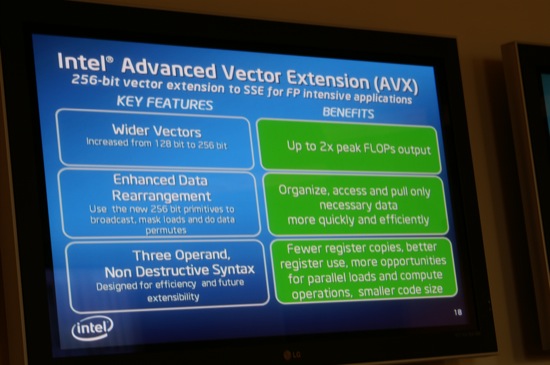Opening the Kimono: Intel Details Nehalem and Tempts with Larrabee
by Anand Lal Shimpi on March 17, 2008 5:00 PM EST- Posted in
- CPUs
Intel also provided a small update on its 32nm processors, Westmere (a 32nm die shrink to Nehalem) and Sandy Bridge (32nm, brand new architecture):
Details on Westmere were light, but Intel did detail that they'd be introducing new vector instructions with the CPU:
The Intel Advanced Vector Extensions (AVX) will not be available in Westmere. Instead, we will have to wait for Sandy Bridge which will offer support for 256-bit vector operations. Intel will detail the full instruction specs at its upcoming IDF in China.












53 Comments
View All Comments
Yongsta - Tuesday, March 18, 2008 - link
Anime Characters don't count.RamIt - Monday, March 17, 2008 - link
Yep, you are the only one that cares :)teko - Monday, March 17, 2008 - link
I also ponder on the title and image. Actually, I clicked and read the whole article trying to look for a connection.Yea, I think it's bad taste.
Owls - Tuesday, March 18, 2008 - link
Who cares. If only Elliot Spitzer paid his hookers in Penryns no one would have known.Deville - Monday, March 17, 2008 - link
Wow! Exciting stuff!AMD? Hello???
InternetGeek - Monday, March 17, 2008 - link
But would you rather buy a Tick processor or a Tock processor?In any case you have to accept that the following generation (Tick or Tock) will perform faster. It's how Intel makes money.
The scenario is that on keeping your computer for 3-4 years. I rekcon that's still the average time. Basically when your GPU can no longer play the new games decently. On the CPU side, I think buying a Tock processor might be a better deal because you're getting the refined version of your generation.
Problem is the way Intel introduces their SIMD extensions. I've seen that done randomly (Ticks or Tocks) and sometimes you do want to have those extensions.
Is there a way to correlate Ticks/Tocks and SIMD extensions?
ocyl - Monday, March 17, 2008 - link
For some unknown reasons, Intel's "tick-tock" terminology is used inversely of the same phrase's common understanding, per Page 4 of the article. With Intel, "tock" refers to a brand new generation, while "tick" refers to refinement of the current generation. Why this is the case, I have no idea.InternetGeek - Monday, March 17, 2008 - link
I think you got it wrong. It is perfectly explained at http://www.intel.com/technology/tick-tock/index.ht...">http://www.intel.com/technology/tick-tock/index.ht...Tick is a new silicon process, Tock is an upgrade.
---
Year 1: "Tick"
Intel delivers a new silicon process technology that dramatically increases transistor density versus the previous generation. This technology is used to enhance performance and energy efficiency by shrinking and refining the existing microarchitecture.
Year 2: "Tock"
Intel delivers an entirely new processor microarchitecture to optimize the value of the increased number of transistor and technology updates that are now available
---
InternetGeek - Monday, March 17, 2008 - link
Ehm, You're actually correct. Tick is the upgrade. Tock is the new thing.masher2 - Monday, March 17, 2008 - link
Not quite. "Tick" is the new silicon process (the shrink). "Tock" is the new uCore architecture. They're both "new things".From a refinement perspective, the Tick generation will also typically include uCore refinements, and the Tock likewise includes process refinements.